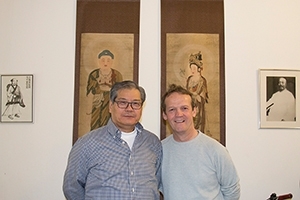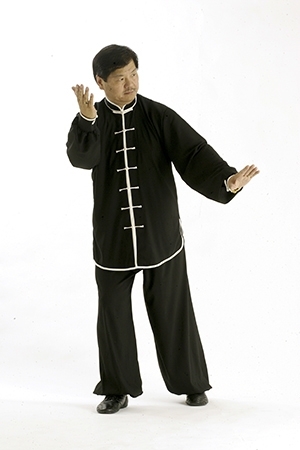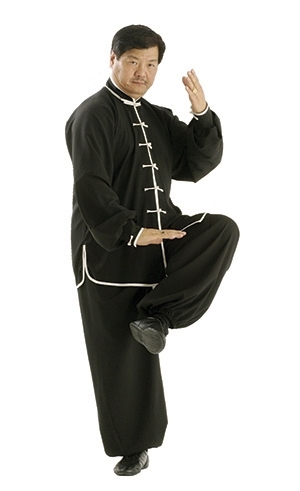An Interview with Grandmaster Wu Kwong Yu by Ronnie Robinson
Following his enthusiastically received session at the recent TCUGB Judge’s Training Seminar in London, Grandmaster Wu Kwong YU (Eddie Wu) and I adjourned to a side room for a brief interview – with the invaluable assistance of Wu’s Tai Chi Chuan Academy senior disciple Steffi Sachsenmaier who recorded the interview and clarified some stylistic technical references.
During our conversation I enquired if he was able to understand my Scottish accent and he responded by saying, “Nae problem Jimmie!” It seems he spent 4 years based in the small Perthshire village of Scone whilst training as an aeronautical engineer in the mid-1970’s.
It was his intention to become an aircraft engineer but, as time passed, he became more involved in the family business of teaching Wu Style Tai Chi Chuan. Being based in Hong Kong, their system of tai chi chuan was always authentic because each generation maintained traditional teaching systems.
The Wu Family moved from Hong Kong to Canada in the late 1970’s where they soon established a training school to continue to the family business of teaching traditional tai chi chuan. Wu Kwong Yu, who had been training as an engineer, was also asked to come to Canada and support the continuing education of the family system. Through time he became the official head of the Wu Family Tai Chi Chuan Academy. The Academy went on to open Wu Family Tai Chi Chuan Academies across the globe including USA, France, Greece, China and Malaysia, with Sifu Gary Wragg being the head of the first London (and European) Academy, currently located in Bethnal Green. By offering a clearly defined training structure, in a full range of tai chi aspects, the Academies have proved successful in training thousands of students across many continents.
We talked about how the old political system in China proved difficult for the continuation of tai chi because the Cultural Revolution frowned upon family practices. This is in stark contrast to how modern China now considers tai chi chuan as a cultural treasure and how they are developing key areas of tai chi significance such as Chenjiagou and Wudang Shan, building training schools, hotels and shopping malls to furnish the growing interest in training close to the source of ‘original’ tai chi chuan.

How do you feel about the current developments with the promotion of tai chi chuan in China?
There have been big changes in China in the past 20 years or so and Deng Xiaoping proclaimed “Taijiquan hao” which means “Tai Chi Chuan is good”. Not only the whole of China but the whole of the world is motivated by these words. So they had to do something to control the standard and the way tai chi was being taught and passed on properly.
Grandmaster Wu had visited China, in an official capacity but told me that he was often considered to be a foreigner and that the Wu Family system, whilst being a key component in the creation of the modern tai chi routines, was becoming increasingly less considered or recognised in the place of its origin. Chen, Yang and Wudang systems had museums showing where they originated but, as far as I’m aware, there is nowhere to indicate the source of the Wu Style.
Whilst there were many positive aspects to this new attitude it had, to a significant extent, also resulted in the distillation of many traditional approaches to the art. With the increase in competitions and international exchanges, many new standardised forms had been created to simplify the marking process and attract more competitors. This enabled more people to be taught clearly and quickly, but the deeper aspects of long-term, traditional training, covering the full curriculum, were often compromised.
In China young people are increasingly inspired by major movie stars like Jet Li who perform dramatic kung fu skills in movies. They see him being famous, rich and successful and want to be like him. In order to do so they learn wushu and enter competitions to be recognised, so there are more competitions, more competitors.
Do you see this as a threat to traditional tai chi?
No. Not at all. People have mentality. If you’re thinking that you want to go that route as a methodist so be it. But then you’ve got to be aware of the potential for buggering up your knees and other such problems that can result from the training required to excel at wushu. If someone is concerned about their health, whatever the style, then they should be concerned with basic fundamentals like not damaging their body. For example, in many of the hard, external systems, if you want to punch well you have to train by punching wood, punching bricks etc. but before you gain any benefit you’ve already damaged your tendons, your nerves and then you can go on to develop rheumatism, when you’re not so old. These practices go against the natural order of things and restrict the potential for longevity.
When you talked about the six levels of training, it’s a very clearly defined system of training and the things you were referring to, particularly with reference to competition. I’m curious to know what percentage of people who study the Wu Style, your style, go through the full curriculum?
I’ll tell you this much, before we focus on the Wu Style, if any judge does not have the knowledge of the common tai chi chuan requirements, or doesn’t recognise that the pelvis has to drop and the hips have to tuck in in order to have basic Yin/Yang separation, or doesn’t recognise that the chin should be down whilst lifting the crown, and the importance of establishing proper posture, then they don’t have the knowledge to define what’s good and right. If you know nothing much about the Wu style then you must know that with the rear foot the toes should be pointing forward so the feet are parallel. It is written in the book and it’s the law, the law as written in the regulations in China. These aspects make it so easy to judge the Wu Style because these are the key aspects that should be looked for. So if the toes are turned out, it’s not even Wu Style to begin with, and I don’t even care how good the other components of the performance are.
So do you think there is a lot of bad Wu Style around?
I wouldn’t comment on that but I see a lot of people around doing tai chi chuan and not tai chi chuan or with a lot of things that are just wrong. However, people are free to do what they want and they can still get health benefits by doing a little exercise, more than they would by doing nothing or by sitting around drinking soft drinks and eating crisps.
Whilst we’re talking about the health aspects, something I’ve always been curious about: in the classical tai chi books that came out of China, in English and other foreign languages in the early days of the spread of the art to the West, of the three books (Yang, Wu & Chen Style) only the Wu Style book contained information on acupoints and meridians. I’ve asked many tai chi practitioners, from across the styles, how much do they relate to these aspects in their training?
You have to have a methodology to stretch the ligaments and this happens when the joints are activated. There’s a term in Chinese, ‘Gong’: Neigong, Qigong. Gong is the essence of the movement. Then you have the capability of delivering Fa Jing, with the correct internal structure of the ligament – bang! Otherwise it’s just a simple, physical push with simple brute force.
Yes, but it must come from the mental intent.
Of course the mind moves the qi, the qi moves the body parts.
But for many practitioners, with the mind intent not in the right place, this will never happen.
Of course and without it it’s just a simple stretching exercise like yoga. When it gets like that they’d be better switching discipline.
In Germany and Holland there are the schools of Ma Jing Bao, who, as you’ll know, is the son of Ma Yeuh Liang and Wu Jin Hua, the daughter of Wu Chien Chuan. However, what they do seems different from what you are doing.

This is family history and you can quote me on it. Ma Jing Bao’s father, Ma Yeuh Liang, who was my grand-uncle, married Wu Chien Chuan’s daughter, Wu Yin Hua. Ma Yeuh Liang learned a hard style before he met his wife. He then studied for a number of years with my grandfather, Wu Chien Chuan, who then passed away. From this point Ma Yeuh Liang had nobody to upgrade with. Wu Yin Hua did exactly what her father did but, as was the tradition in China, men came first. So she walked behind her husband and followed what he did. So then, as time passed, Ma Yeuh Liang merged his semi-hard style and Wu style forms together, which is the system that is now practised by Ma Jing Bao and his students. Now everybody has his or her areas of expertise but this is not the same system as the Wu family system. We have brought the direct lineage from my great-grandfather, grandfather and father to myself.
You can see in the 1995 video from the exhibition in Toronto where my aunt, my two sons, my sister and myself practised from the start of the form to the 450 push and everything was identical, without rehearsal. This is because we were all taught in the same way and this has been my job since 2004, when I moved from Hong Kong to continue the family tradition. It is my job to unify and maintain this system of tai chi for this generation and for the generations hereafter. There will be no watering down and everything will be kept clear. I’m very proud to be the 5th Generation holder of the Wu Family system with 150 years plus of education. It doesn’t always have to be of the highest standard but at least a clear method for precise teaching will be passed down to each generation.
You seem like you still enjoy it?
I do. I’m 68 and started studying at the age of 6 and I take it as a responsibility to pass on the knowledge. I gave up my profession as an engineer. I studied in Perth in Scotland for 4 years as an aircraft engineer and worked for 2 years before taking over the family teaching after my grandfather and father passed away. My uncle carried on the wishes of my father to teach and promote our style in Canada after a lot of their students and disciples had emigrated there. However, he was by then in his early 60’s and didn’t speak English, which made it difficult for him to work with non-Chinese beginners. After 3 months there I got a phone call asking me to join him to help with the teaching. A few months after that he returned to Hong Kong and left it to me to continue with the teaching in Canada. It wasn’t my intention to do so as I had other skills, not only as an engineer but experience in business too. However, within three months I was granted citizenship on the basis of my ability to be an engineer and teach tai chi.
I also developed a reputation as an authentic tai chi teacher. If you wanted to learn tai chi for self-defence, I was the person to come to.
In 1985, we made our connections with Gary and the European schools were developed.
We also founded the Canadian Wushu Federation, which has recognition through the Canadian government.
So anyone who is practising and training in Wu Style Tai Chi Chuan should have a connection to your family?
No. We have many branches all over the world and they include people who could have learned from me, my father, grandfather, uncle etc. However, there are also students who, because of distance, are not connected directly to me or to my family. In this case it’s likely that the quality will be watered down, as they’re not connected to our structured system of learning.
Also recomended reading on Wu Style
Grandmaster Wu Kwong Yu is the head of the International Wu Style Tai Chi Chuan Association and is based in Canada.
Sifu Gary Wragg is the Head of the Wu’s Tai Chi Chuan Academy, Europe and is based in London.
Author: Ronnie Robinson
Images: Wu Kwong Yu and Ronnie Robinson

